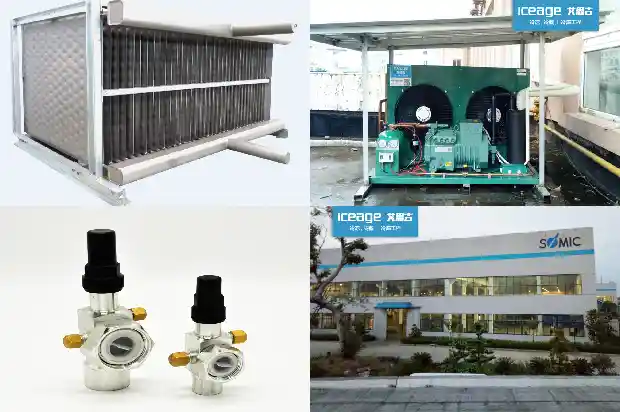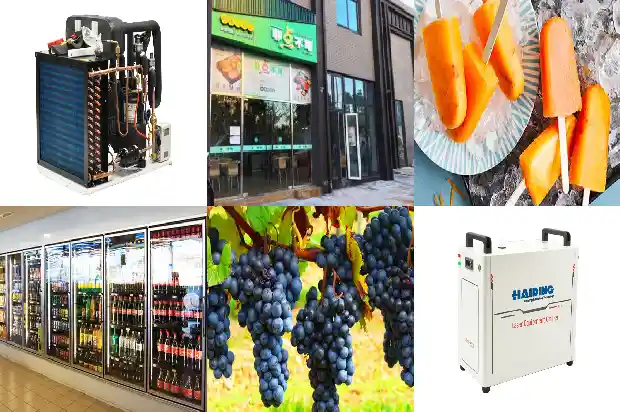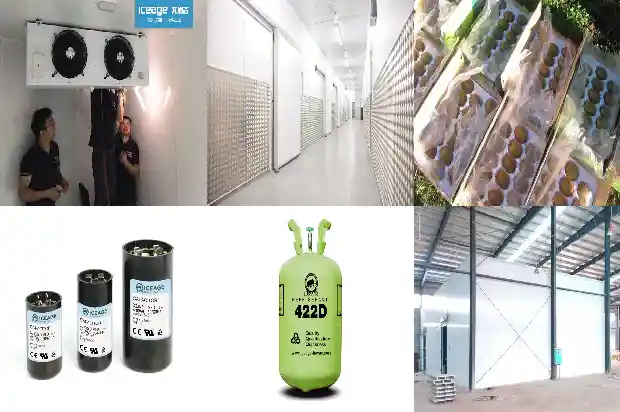A Summary of 11 Common Faults in Refrigeration and Air Conditioning Systems
2025-03-30
The substances in the refrigeration system cycle include refrigerant, oil, water, air, and other impurities, a total of five. The first two are necessary to ensure the normal operation of the system, while the latter three are harmful to the system, yet cannot be completely eliminated. At the same time, the refrigerant itself has three states: vapor phase, liquid phase, and vapor - liquid mixed phase. Therefore, once a failure occurs in the air - conditioning refrigeration system, its symptoms and causes are relatively complex. The following lists eleven common faults of the air - conditioning refrigeration system.
- The fan does not rotate: There are two reasons for the fan not to rotate. One is an electrical fault, and the control circuit is not connected.
The other is a mechanical fault of the fan shaft. When the fan of the room air conditioner does not rotate, the temperature of the air - conditioned room will rise, and both the suction pressure and the discharge pressure of the compressor will decrease to a certain extent. After the air - conditioner fan stops rotating, the heat - exchange efficiency of the heat - exchange coil in the air - conditioned room decreases. When the heat load of the air - conditioned room remains unchanged, the temperature of the air - conditioned room will rise.
The refrigerant in the heat - exchange coil has a relatively lower temperature than the original due to insufficient heat - exchange, that is, the evaporation temperature becomes smaller, and the refrigeration coefficient of the system decreases. The temperature at the outlet of the evaporator sensed by the thermostatic expansion valve also decreases, causing the opening of the thermostatic expansion valve to become smaller, and the refrigerant also decreases accordingly. So both the suction and discharge pressures become smaller. The overall effect of the reduction in refrigerant flow and the decrease in the refrigeration coefficient is a decrease in the system's cooling capacity. - The inlet temperature of cooling water is too low:
As the temperature of the cooling water decreases, the discharge pressure, discharge temperature of the compressor, and the temperature at the outlet of the filter all decrease. However, the temperature of the air - conditioned room still remains unchanged because the cooling water temperature has not dropped to the extent that it will affect the refrigeration effect. If the cooling water temperature drops to a certain level, the condensing pressure will also decrease, resulting in a decrease in the pressure difference on both sides of the thermostatic expansion valve. The flow capacity of the thermostatic expansion valve also decreases accordingly, and the refrigerant decreases, so the refrigeration effect will be reduced. - The inlet temperature of cooling water is too high:
If the inlet temperature of the cooling water is too high, the sub - cooling temperature of the refrigerant, the condensing temperature will be too high, and the condensing pressure will also be correspondingly too high. The compression ratio of the compressor increases, the shaft power increases, and the volumetric efficiency decreases.
Therefore, the refrigeration capacity of the system is reduced. So the overall refrigeration effect will be reduced, and the temperature of the air - conditioned room will rise.
- The circulating water pump does not rotate:
When commissioning and operating the refrigeration unit, the system circulating water pump should be turned on first. When the circulating water pump does not rotate, the outlet temperature of the cooling water and the outlet temperature of the refrigerant in the condenser rise most obviously. Due to the sharp decrease in the cooling effect of the condenser, the suction temperature and discharge temperature of the compressor also rise rapidly. The rise in the condensing temperature also causes the evaporation temperature to rise, but the increase in the evaporation temperature is not as large as the increase in the condensing temperature. So the refrigeration efficiency is reduced, and the temperature of the air - conditioned room rises rapidly. - The filter is blocked:
The blockage of the filter means the system is dirty - blocked. Generally, the dirty - blockage often occurs at the filter because the filter screen of the filter blocks the channel cross - section, filtering out dirt, metal shavings, and other debris. Over time, the refrigeration and air - conditioning are blocked. The consequence of the filter blockage is a reduction in the refrigerant circulation. Many of its reasons are similar to the too - small opening of the expansion valve, such as the rise in the suction and discharge temperatures of the compressor, the drop in the suction and discharge pressures of the compressor, and the rise in the temperature of the air - conditioned room. The difference is that the temperature at the outlet of the filter becomes lower and lower. This is because throttling starts at the filter, causing the local temperature of the system to decrease. In severe cases, local frosting or icing of the system will occur. - The load of the air - conditioned room is too large:
Due to the influence of internal and external disturbances in the room and various factors, an excessive load in the air - conditioned room will cause the temperature of the air - conditioned room to rise, and finally, the temperature index that a normal air - conditioned room should maintain cannot be reached. At the same time, the two parameters most affected are the suction temperature and the discharge temperature of the compressor.
Due to the influence of the heat capacity of the air - conditioned room, it will take a certain amount of time for the influence on other parameters to become obvious. - The flow rate of cooling water is too small:
Due to the relationship between the cooling water pipes and cooling water valves, as well as the small configuration of the cooling tower in the system or too much scale in the cooling tower, a too - small flow rate of cooling water and a too - high inlet temperature of cooling water are also common faults.
When the flow rate of cooling water is too small, the heat - exchange effect of the condenser decreases. Therefore, the temperature of the refrigerant at the outlet of the condenser rises, the condensing temperature of the refrigerant rises, the refrigeration coefficient is reduced, and the refrigeration effect is affected.
Under the condition that other conditions remain unchanged, the temperature of the air - conditioned room will also rise to a certain extent, and the suction temperature of the compressor will also rise. But the most obvious change is that the temperature difference at the outlet of the cooling water will become larger and larger. - The opening of the expansion valve is too small:
The too - small opening of the expansion valve is in terms of the normal refrigerant charge in the refrigeration system. In the fault of the too - small opening of the expansion valve, the refrigerant circulation in the entire system is insufficient. When other working conditions remain unchanged, it cannot fully meet the need for liquid refrigerant to vaporize and absorb heat under low pressure. Therefore, the superheat degree of the return air is very large, the suction and discharge temperatures and the temperature of the air - conditioned room will rise, and the suction and discharge pressures will drop.
The temperature of the refrigerant at the outlet of the condenser will drop (that is, the refrigeration capacity of the system is increased) because the heat - exchange capacity of the condenser has not changed, but the refrigerant flow rate circulating in the entire system is very small. Although the refrigeration coefficient is increased and the unit refrigeration capacity is increased at this time. But the total cooling capacity has decreased, so the temperature of the air - conditioned room will rise. There is a small opening in the expansion valve. Adjusting the opening of the expansion valve is to adjust the size of that small opening. The larger the opening, the larger the caliber, and the more liquid will flow through. - Insufficient refrigerant:
Insufficient refrigerant is usually caused by two reasons. One is that the charge is insufficient before the product leaves the factory, which generally occurs less frequently. The other is that the unit operates all year round, and the refrigerant is reduced due to leakage at the system valves or welding parts. Therefore, it is a relatively common fault. There is no obvious difference in the causes of the two faults of insufficient refrigerant and the too - small opening of the expansion valve. - Excessive refrigerant:
Excessive refrigerant comes from blind refrigerant charging, which is not uncommon during the maintenance of the refrigeration system. This will reduce the effective heat - exchange area in the condenser, reduce the heat - exchange effect, cause the condensing temperature to rise, the condensing pressure to increase, and the high - pressure to be too high.
Excessive refrigerant enters the evaporator and fails to be completely vaporized and is sucked into the compressor, resulting in high low - pressure. The cylinder head of the compressor condenses or frosts. In severe cases, a liquid - hammering accident will occur.
Part of the liquid refrigerant enters the compressor, increasing the motor load, making it difficult to start, and overloading the current during operation. In severe cases, the motor will burn out due to overload.
- Compressor damage:
The damage of the scroll disk of the compressor or the damage of the suction and discharge valve plates is a common mechanical fault. When the fault occurs, the suction temperature and suction pressure will rise, and the discharge temperature and discharge pressure will drop. This is equivalent to a reduction in the actual gas delivery volume of the compressor. So the refrigeration effect is poor, and the temperature of the air - conditioned room will rise quickly. In severe cases, the low - pressure relay will stop the compressor.
Related Articles
- Summary of HVAC Design Parameters for Residential Buildings
- 【HVAC Design Summary】 - Free Cooling with Cooling Towers
- Operation: Analysis of 20 Major Faults of Screw Compressors!
- Analysis and Solutions for Common Faults in Refrigeration Systems
- Structure and Common Faults of Hermetic Compressors
- Common Faults and Solutions in Cold Storage Maintenance
- Common Faults and Treatment Methods of Single-phase Asynchronous Motors
- Common Faults and Daily Maintenance of Commercial Ice Makers
- Analysis of Common Faults of Chillers
- Wiring Methods, Faults and Classifications of Fan Coil Units, All Here~~
- Eliminate the "Blockage" Faults (Ice Blockage, Dirt Blockage, Oil Blockage) of the Refrigeration System in 5 Minutes
- How to Inspect and Troubleshoot the Faults of the Control Valve in the Cold Storage?
- Common Faults in Refrigeration Systems and Handling Methods
- What Are the Common Causes of High - pressure Faults in Chillers?
- Basic Faults and Preventive Maintenance of Water - cooled Units
- Composition and Common Faults of Screw Refrigeration Compressors
- Common Faults and Solutions of Central Air - conditioning Chiller Units
- Common Faults of Industrial Chillers
